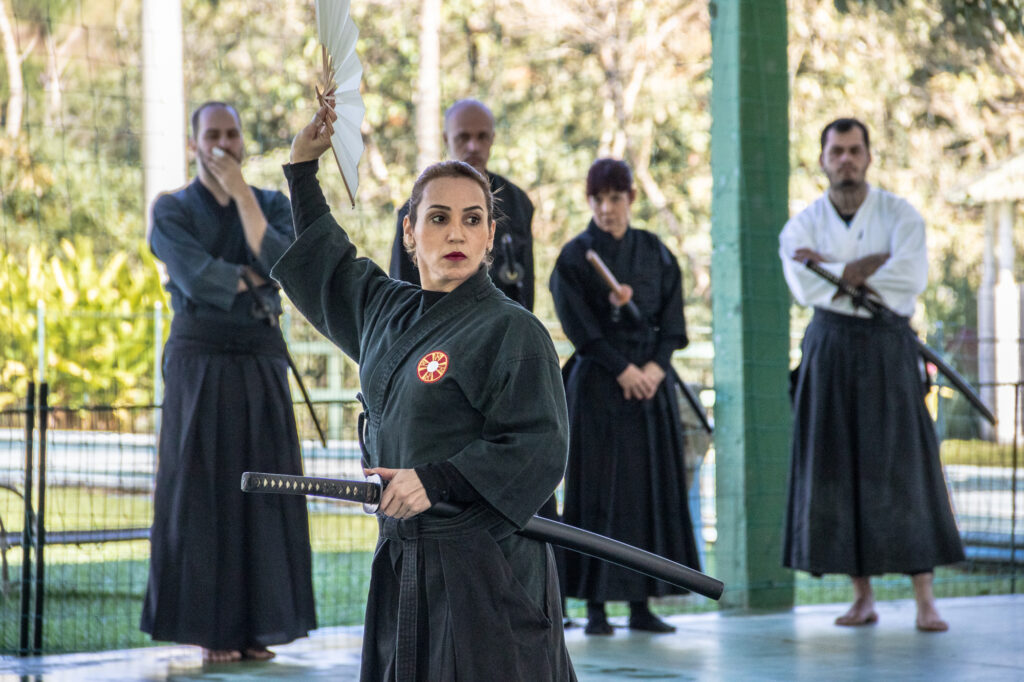

Shinto Ryu Budo
Hibino Raifu Kaiso says that Shinto Ryu begins with reverence and concentration (rei) and ends with a deep feeling of gratitude. It is based on the principles of Kenjutsu, Iai Do and old style kata of Bujutsu (Koryu Bujutsu), valuing respect, mastery of the sword (katana), posture and correct movement, whether standing or sitting. Their training, carried out with the sword, also promotes better concentration, attention and memory, in addition to training the body, cultivating Ki (Vital Energy), cutting and forming character. According to the founder, Hibino Raifu, cultivating a person’s character allows him to live in a condition of Ryoofuu meigetsu (soft breeze and clear moon, which represent the serenity of the spirit free from cloudiness), even though he is exposed to the storms of life and the tremors of heaven and earth. This is the true essence of Shinto Ryu Budo. The paths of Shinto Ryu Budo are: Kenbu-Do, Shibu-Do, Iai-Do, Iai-Battô-Jutsu and Gin-ei (poem and chant).
IAI DO
Iai Do – “The Path of Union with Being”, aims at the physical and spiritual improvement of students. It is practiced to polish the spirit, and the training aims at human development and the application of this knowledge in daily life, which can be used in any field of activity. All the gestures and movements of Iai Do are intended to exercise and develop discernment, imagination, attention, memory, in short, center consciousness in the present moment; the control of the body with a lucid and objective mind that dominates the fluctuations of desires, fear, anxiety before the result. With this, an immediate adaptation is generated in the face of the unusual, remaining serene, which will allow an instant evaluation for each moment or circumstance. Behavior is of utmost respect and courtesy under all circumstances. It is a martial philosophy, a philosophy of life.
IAI BATTO JUTSU
Using the katas of Shinto Ryu Iai Do, in this modality, the accurate and perfect cut is trained. For this, the makiwara (rice straw mat prepared for this purpose) and the cutting sword are used. In training, we aim at the development of Shinken (inner sword), that is, Katsujinken (life-giving sword), which is the manifestation of the will through discipline in a ceremonial form. Iai Do aims at transparency, that is, at fighting the illusions of the mind, our inner enemies. Battô, on the other hand, aims at technical excellence, at the use of the sword against external enemies. Following this thought, in training, despite using the sword and his own body, the practitioner would be training the skill of inner fighting. The program consists of Omote no Kata, Ura no Kata, Tameshigiri and Kumitachi
KENBU DO
The demonstration of this Martial Art as a Warrior Dance, presents the unsheathed sword accompanied by the Japanese chant Gin-ei. This dance was organized and grouped into katas, introduced to the world in the Meiji Era in the year 23 (1890) by the founder of the Shinto Ryu style, Hibino Raifu. In Japan, Hibino was considered the father of modern Kenbu. In the Shinto Ryu style, Kenbu Do was built on the basis of Kenjutsu and traditional Japanese Iai, adding principles of jujutsu and karate, as well as elements of Buyou Mai dance. Therefore, in every detail of the movements of the arms or legs, the basis of the essence of the Martial Arts is present. Shinto Ryu practitioners spare no effort to present in dance the understanding of Gin-ei’s poem, and show in the play the grandeur, elegance and character of the work. In Shinto Ryu, Kenbu Do was introduced as Kenbujutsu, that is, kenbu with the dance Kanji (bu). As the martial character of the dance was not understood, in 1906, the Kanji was changed to Bu, which means warrior. It is a Dance that represents moments in history, the warriors of Japan and their sagas. The aesthetics of this technique, the feeling it conveys and the drama resulting from the action in the kata gradually lead the practitioner to understand Bushido and start using it in his life. In addition to the Iaito, or special sword for training, the fan is used.
SHIBU DO
It is the dance that uses one or two fans, accompanied by the music Gin-ei. It differs from the usual Japanese dance by having the characteristic movement of the Martial Art base, Taisabaki. Use the fan, which symbolizes the sword or other weapon of the Martial Art. Shibu-Do makes use of martial poems, chants and dances with the intention of exalting the spirit of the sword, which is its philosophy. Being individual or collective, they bring to light the martial arts tradition and, with it, the transmission of the warriors’ knowledge.
GIN EI
The practitioner trains to understand the Gin-ei poem and sing it specifically to accompany the demonstration of Shinto Ryu Budo. With practice, the student acquires experience, being able to maintain a correct posture. This will allow your voice to express, through singing, the spirit and message of the piece represented.

